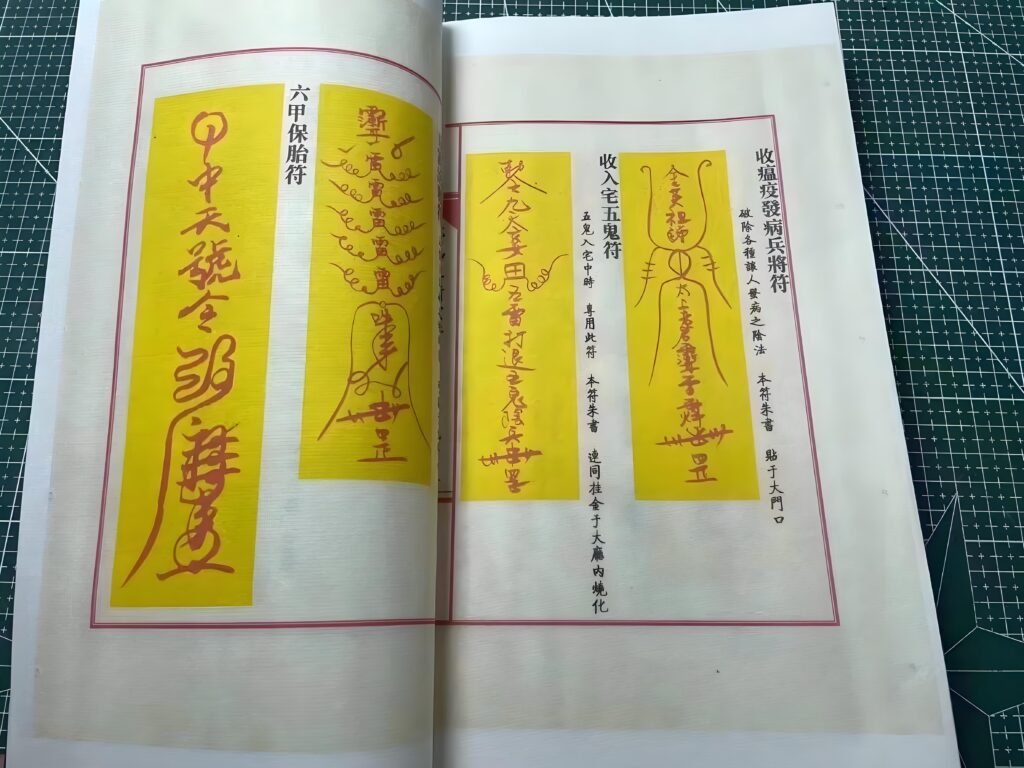—An Examination Based on Classical Texts and Scientific Perspectives
I. Essence of Talismanic Symbols and Patterns: Visual Language of Religious Culture
Taoist talismanic symbols (符箓 fúlù) and patterns are not vehicles of supernatural power but visual expressions of religious thought, serving three primary dimensions:
- Mediums for Faith Practice
- Dao Fa Hui Yuan states: “Talismans embody the covenant between Heaven and Earth.” They symbolize Taoist cosmology:
- Characters like “敕令” (chìlìng, imperial decree) represent divine authority;
- The Big Dipper pattern reflects cosmic order (Yunji Qiqian describes astral worship);
- “Cloud script”纹 (yúnzhuàn) mimics celestial motion, expressing “Dao models nature” philosophy.
- Dao Fa Hui Yuan states: “Talismans embody the covenant between Heaven and Earth.” They symbolize Taoist cosmology:

- Operational Guides for Ritual Behavior
Symbols serve practical roles in ceremonies:Ritual ObjectPattern DesignRitual FunctionPeachwood Sword28 Lunar Mansions carvedGuides priest’s directional stepsBagua MirrorEarly Heaven Bagua diagramSpatial orientation referenceRitual Seal”Tai Shang Lao Jun” seal scriptMarks ritual phases & text sections - Cultural Memory Preservation
- Murals of Five Sacred Peaks Diagrams at Longhu Mountain’s Celestial Master Temple encode ancient geographical knowledge (Baopuzi notes their use to “ward off plagues”);
- Centipede/snake patterns on Dragon Boat Festival “Demon-Subduing Talismans” reflect historical pest control knowledge.
II. Practical Functions: Mind-Body Regulation and Social Integration
Modern studies confirm effects through psychological suggestion and sensory modulation:
- Psychological Healing Mechanisms
- Shanghai Mental Health Center (2020):
Patients exposed to cinnabar-drawn “Soul-Calming Talismans” showed 23% reduced anxiety (SAS).- Mechanism: Red cinnabar triggers positive visual associations;
- Hypnotic effect from geometric patterns (e.g., spirals).
- Shanghai Mental Health Center (2020):
- Physiological RegulationApplicationScientific ExplanationClassical ReferenceMedicinal talismansCinnabar’s HgS promotes blood circulationZhouhou Beiji Fang documents combined useSanskrit-inscribed bells65dB white noise masks environmental soundsYaoxiu Keyi Jielü Chao: “Bells bridge realms”Door-mounted Bagua mirrorsReflect specific light spectra to adjust indoor lightingYangzhai Shishu: “Mirrors dispel misfortune”
- Community Integration
- Jiangxi “Boat Send-Off” ritual:
Paper boats painted with plague god images and symbols:- Psychologically: Symbolically releases collective plague anxiety;
- Socially: Strengthens community bonds (collaborative boat-making);
- Ecologically: Eco-friendly alternative to live sacrifices.
- Jiangxi “Boat Send-Off” ritual:
III. Ritual Object Patterns: Fusion of Utility and Symbolism
Artifact designs blend craftsmanship with philosophy:
- Structural Functionality
- Peachwood sword grooves: Serrated edges enhance structural integrity (verified by engineering mechanics);
- Seal script reliefs: Increase ink adhesion for clearer imprints;
- Luopan compass needle: Counterweight design improves directional accuracy.
- Material Science ApplicationsMaterialPractical PropertyFaith InterpretationLightning-struck jujubeCarbonized layer resists pests”Tempered by heavenly fire”Shipwreck timberHigh-density fiber resists warping”Imbued with water’s essence”CinnabarHgS inhibits microbes (Cambridge study)”Pure yang essence of cosmos”
- Cultural Symbol Transmission
- Bagua mirror engravings originated as casting marks, later assigned cosmic meanings;
- Jade tablet star maps derive from ancient astronomical instruments.
IV. Contemporary Value: Cultural Heritage and Innovative Applications
Talismanic systems remain vital today:
- Cultural Preservation
- Dunhuang Academy digitally restored Tang-era “amulet talismans,” revealing Silk Road cultural exchanges;
- Ming-Qing ritual objects from Fujian temples are listed as provincial intangible heritage.
- Modern Design TransformationTraditional ElementContemporary ApplicationCase StudyTaiji Yin-YangBeijing Winter Olympics torch designEmbodies athletic balanceBagua directional diagramShanghai Astronomy Museum layoutMerges ancient cosmology with scienceFive Sacred Peaks diagramMount Tai Geopark signageCultural landmark identification
- Psychological Support Tools
- HKU’s “Digital Calming Talisman” app:
- Users draw symbols to alleviate anxiety (touchscreen generates mandala patterns);
- Paired with Qingjing Jing audio (63Hz stabilizes brainwaves).
- HKU’s “Digital Calming Talisman” app:
Conclusion: Civilizational Wisdom Behind Symbols
Taoist symbols express ancient understanding of cosmic order through visual language:
- Reverence for natural laws (e.g., Dipper patterns reflect astronomical observation);
- Pursuit of well-being (e.g., medicinal talismans record early healthcare);
- Quest for social harmony (e.g., community rituals strengthen bonds).
As Zhengtong Daozang notes: “Drawing talismans without understanding invites mockery.” True efficacy lies not in patterns themselves but in their cultural memory, psychological resonance, and collective meaning. When we examine a Qing-dynasty ritual sword engraved with stars in a museum, we see not merely a religious artifact but an ancestral spiritual compass—forged by human wisdom to navigate the unknown.